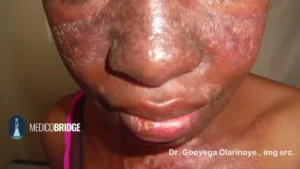Author's details
- Dr. Khashau Eleburuike
- MBBS (Ilorin) MSc. Global Health Karolinska Institute.
- Resident doctor in family medicine in Northen Sweden.
Reviewer's details
- Dr. Gboyega Olarinoye
- MBBS, FMCP.
- Dermatologist FMC Keffi Nassarawa State. Nigeria
- Date Uploaded: 2025-07-21
- Date Updated: 2025-07-31
Systemic lupus erythematosus
Background
Systemic lupus erythematosus (SLE) is a chronic autoimmune disease that often presents more severely in individuals with African ancestry, with common skin signs including dark hyperpigmented or hypopigmented patches, scarring alopecia, and discoid lesions, especially on sun-exposed areas. Photosensitivity may manifest differently, with post-inflammatory hyperpigmentation more pronounced than redness. Management includes sunscreen use, hydroxychloroquine, corticosteroids, and immunosuppressants, tailored to minimize skin damage and systemic involvement. Early diagnosis and regular follow-up are crucial to prevent complications like lupus nephritis, which is more prevalent in African populations.
Lesion image

References
- Okeke T et al. Systemic lupus erythematosus in sub-Saharan Africa: a review. Lupus. 2022.
- Ogunbiyi A. Skin disorders in African skin: the impact of pigmentation. Int J Dermatol. 2020.

